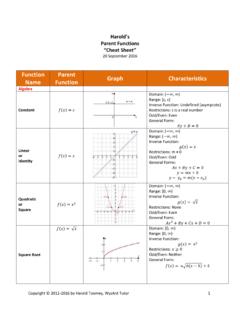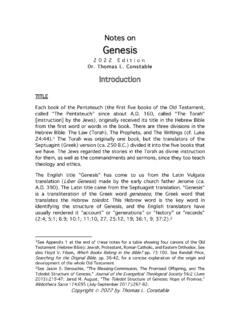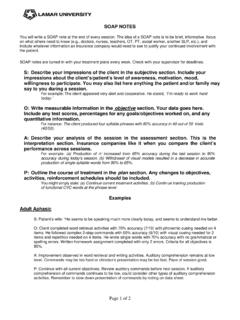Transcription of Harold’s Calculus Notes Cheat Sheet - Toomey
1 harold 's Calculus Notes Cheat Sheet 4 April 2020. AP Calculus Limits Definition of Limit Let f be a function defined on an open interval containing c and let L be a real number. The statement: lim ( ) = .. means that for each > 0 there exists a > 0 such that if 0 < | | < , then | ( ) | < . Tip : Direct substitution: Plug in ( ) and see if it provides a legal answer. If so then L =. ( ). The Existence of a Limit lim ( ) = .. The limit of ( ) as approaches a is L if lim ( ) = . and only if: +.. Prove that ( ) = is a continuous function. | ( ) ( )|. Definition of Continuity = |( 2 1) ( 2 1)|. = | 2 1 2 + 1|. A function f is continuous at c if for = | 2 2 |. every > 0 there exists a > 0 such that = |( + )( )|. | | < and | ( ) ( )| < . = |( + )| |( )|. Since |( + )| |2 |. Tip: Rearrange | ( ) ( )| to have | ( ) ( )| |2 ||( )| < .. |( )| as a factor. Since | | < we So, given > 0, we can choose = | | > in the . can find an equation that relates both Definition of Continuity.
2 So, substituting the chosen . and together. for |( )| we get: 1. | ( ) ( )| |2 | (| | ) = . 2 . Since both conditions are met, ( ) is continuous.. =1. 0 . Two Special Trig Limits 1 . =0. 0 . Copyright 2015-2020 by harold Toomey , WyzAnt Tutor 1. Derivatives (See Larson's 1-pager of common derivatives). ( + ) ( ). Definition of a Derivative of a Function ( ) = lim 0 . Slope Function ( ) ( ). ( ) = lim .. Notation for Derivatives ( ), ( ) ( ), , , [ ( )], [ ].. [ ( ( ))] = ( ( )) ( ). 0. The Chain Rule .. = .. 1. The Constant Multiple Rule [ ( )] = ( ).. 2. The Sum and Difference Rule [ ( ) ( )] = ( ) ( ).. 3. The Product Rule [ ] = + .. 4. The Quotient Rule [ ]=. 2.. 5. The Constant Rule [ ] = 0.. 6a. The Power Rule [ ] = 1.. 6b. The General Power Rule [ ] = 1 where = ( ).. 7. The Power Rule for x [ ] = 1 (think = 1 and 0 = 1).. 8. Absolute Value [| |] =. | |. 1. 9. Natural Logorithm [ln ] =.. 10. Natural Exponential [ ] =.
3 1. 11. Logorithm [log ] =. (ln ) .. 12. Exponential [ ] = (ln ) .. 13. Sine [ ( )] = cos( ).. 14. Cosine [ ( )] = ( ).. 15. Tangent [ ( )] = 2 ( ).. 16. Cotangent [ ( )] = 2 ( ).. 17. Secant [ ( )] = ( ) ( ).. Copyright 2015-2020 by harold Toomey , WyzAnt Tutor 2. Derivatives (See Larson's 1-pager of common derivatives).. 18. Cosecant [ ( )] = ( ) ( ).. 1. 19. Arcsine [sin 1 ( )] =. 1 2. 1. 20. Arccosine [cos 1( )] =. 1 2. 1. 21. Arctangent [tan 1( )] =. 1 + 2. 1. 22. Arccotangent [cot 1 ( )] =. 1 + 2. 1. 23. Arcsecant [sec 1( )] =. | | 2 1. 1. 24. Arccosecant [csc 1 ( )] =. | | 2 1.. 25. Hyperbolic Sine ( . ) [ ( )] = cosh( ).. + . 26. Hyperbolic Cosine ( ) [ ( )] = ( ).. 27. Hyperbolic Tangent [ ( )] = 2( ).. 28. Hyperbolic Cotangent [ ( )] = 2 ( ).. 29. Hyperbolic Secant [ ( )] = ( ) ( ).. 30. Hyperbolic Cosecant [ ( )] = ( ) ( ).. 1. 31. Hyperbolic Arcsine [sinh 1( )] =. 2 + 1. 1. 32. Hyperbolic Arccosine [cosh 1( )] =.
4 2. 1. 1. 33. Hyperbolic Arctangent [tanh 1 ( )] =. 1 2. 1. 34. Hyperbolic Arccotangent [coth 1( )] =. 1 2. 1. 35. Hyperbolic Arcsecant [sech 1( )] =. 1 2. 1. 36. Hyperbolic Arccosecant [csch 1( )] =. | | 1 + 2. 1. Position Function ( ) = 2 + 0 + 0. 2. Velocity Function ( ) = ( ) = + 0. Acceleration Function ( ) = ( ) = ( ). Jerk Function ( ) = ( ) = ( ) = (3) ( ). Copyright 2015-2020 by harold Toomey , WyzAnt Tutor 3. Analyzing the Graph of a (See harold 's Illegals and Graphing Rationals Cheat Sheet ). Function x-Intercepts (Zeros or Roots) ( ) = 0. y-Intercept (0) = . Domain Valid values Range Valid values Continuity No division by 0, no negative square roots or logs Vertical Asymptotes (VA) = division by 0 or undefined Horizontal Asymptotes (HA) lim ( ) and lim+ ( ) .. Infinite Limits at Infinity lim ( ) and lim+ ( ) .. Differentiability Limit from both directions arrives at the same slope Relative Extrema Create a table with domains: ( ), ( ), ( ).
5 If ( ) +, then cup up . Concavity If ( ) , then cup down . Points of Inflection ( ) = 0 (concavity changes). Graphing with Derivatives 1. If ( ) > 0, then f is increasing (slope up) . Test for Increasing and Decreasing 2. If ( ) < 0, then f is decreasing (slope down) . Functions 3. If ( ) = 0, then f is constant (zero slope) . 1. If ( ) changes from to + at c, then f has a relative minimum at (c, f(c)). The First Derivative Test 2. If ( ) changes from + to - at c, then f has a relative maximum at (c, f(c)). 3. If ( ), is + c + or - c -, then ( ) is neither 1. If ( ) > 0, then f has a relative minimum at ( , ( )). The Second Deriviative Test 2. If ( ) < 0, then f has a relative maximum at ( , ( )). Let f '(c)=0, and f (x) exists, then 3. If ( ) = 0, then the test fails (See 1 derivative test). 1. If ( ) > 0 for all , then the graph is concave up . Test for Concavity 2. If ( ) < 0for all , then the graph is concave down . If ( , ( )) is a point of inflection of ( ), then either Points of Inflection 1.
6 ( ) = 0 or Change in concavity 2. ( ) does not exist at x = c Tangent Lines Genreal Form + + = 0. Slope-Intercept Form = + . Point-Slope Form 0 = ( 0 ). Calculus Form = ( )( ) + ( ). rise 2 1 . Slope = = = = = ( ). run 2 1 . Copyright 2015-2020 by harold Toomey , WyzAnt Tutor 4. Differentiation & Differentials Rolle's Theorem If ( ) = ( ), then there exists at least one number f is continuous on the closed interval [a,b], and c in (a,b) such that ( ) = 0. f is differentiable on the open interval (a,b). Mean Value Theorem ( ) ( ) . If f meets the conditions of Rolle's Theorem, ( ) = =.. then you can find c'. ( ) = ( ) + ( ) ( ). If takes values ( ) and ( ) at each end of the interval, then it also takes any value between ( ). and ( ) at some point within the interval. Intermediate Value Theorem f is a continuous function with an interval, [a, b], as its domain. ( + ) = ( ) + = ( ) + ( ) . = ( ) so = ( ) . Calculating Differentials.
7 Tanget line approximation. Relative Error = in %.. 4. Example: 82 ( ) = 4 , ( + ) = (81 + 1). ( ). Newton's Method +1 = . ( ). Finds zeros of f, or finds c if f(c) = 0. 4. Example: 82 ( ) = 4 82 = 0, = 3. Steps to solve: 1. Identify the known variables and rates of change.. = 15 ; = 20 ; = 2 ; = ? . 2. Construct an equation relating these quantities. 2 + 2 = 2. 3. Differentiate both sides of the equation. Related Rates 2 + 2 = 0. 4. Solve for the desired rate of change.. = .. 5. Substitute the known rates of change and quantities into the equation. 15 3 . = 2 =. 20 2 . ( ). lim ( ) = lim and ( ). 0 . L'H pital's Rule { , , 0 , 1 , 00 , 0 , } , but not {0 }, 0 . ( ) ( ) ( ). then lim = lim = lim = . ( ) ( ) ( ). Copyright 2015-2020 by harold Toomey , WyzAnt Tutor 5. Summation Formulas . = . =1.. ( + 1) 2 . = = +. 2 2 2. =1.. ( + 1)(2 + 1) 3 2 . 2 = = + +. 6 3 2 6. =1. 2. 3. 2 ( + 1)2 4 3 2. = ( ) = = + +. 4 4 2 4. =1 =1.. ( + 1)(2 + 1)(3 2 + 3 1) 5 4 3.
8 4 = = + + . Sum of Powers 30 5 2 3 30. =1.. 2 ( + 1)2 (2 2 + 2 1) 6 5 5 4 2. 5 = = + + . 12 6 2 12 12. =1.. ( + 1)(2 + 1)(3 4 + 6 3 3 + 1). 6. =. 42. =1.. 2 ( + 1)2 (3 4 + 6 3 2 4 + 2). 7. =. 24. =1. 1. ( + 1) +1.. 1 +1. ( ) = = ( ) ( ). +1 +1 . =1 =0.. 2. ( + 1)( + 2). ( + 1) = + =. 3. =1 =1 =1.. Interesting Summation 1 . =. Formulas ( + 1) + 1. =1.. 1 ( + 3). =. ( + 1)( + 2) 4( + 1)( + 2). =1. Copyright 2015-2020 by harold Toomey , WyzAnt Tutor 6. Numerical Methods . 0 ( ) = ( ) = lim ( ) . 0. =1. where = 0 < 1 < 2 < < = . and = 1. Riemann Sum and = { }. Types: Left Sum (LHS). Middle Sum (MHS). Right Sum (RHS).. 0 ( ) = ( ) ( ) =. =1. Midpoint Rule [ ( 1 ) + ( 2 ) + ( 3 ) + + ( )].. (Middle Sum) where =.. 1. and = ( 1 + ) = [ 1 , ]. 2. ( )3. Error Bounds: | | 24 2.. 1 ( ) = ( ) .. [ ( 0 ) + 2 ( 1 ) + 2 ( 3 ) + + 2 ( 1 ). 2. Trapezoidal Rule + ( )].. where =.. and = + . ( )3. Error Bounds: | | . 12 2.. 2 ( ) = ( ) .. [ ( 0 ) + 4 ( 1 ) + 2 ( 2 ) + 4 ( 3 ) +.]
9 3. Simpson's Rule + 2 ( 2 ) + 4 ( 1 ) + ( )]. Where n is even . and = . and = + . ( )5. Error Bounds: | | 180 4. [MATH] fnInt(f(x),x,a,b), [MATH] [1] [ENTER]. TI-84 Plus Example: [MATH] fnInt(x^2,x,0,1). 1. 1. 2 =. 0 3. [MENU] [4] Calculus [3] Integral [TAB] [TAB]. [X] [^] [2] [TAB]. TI-Nspire CAS. [TAB] [X] [ENTER]. Shortcut: [ALPHA] [WINDOWS] [4]. Copyright 2015-2020 by harold Toomey , WyzAnt Tutor 7. Integration (See harold 's Fundamental Theorem of Calculus Cheat Sheet ). Basic Integration Rules ( ) = ( ) + . Integration is the inverse of . differentiation, and vice versa. ( ) = ( ).. ( ) = 0 0 = . ( ) = = 0 = + . 1. The Constant Multiple Rule ( ) = ( ) . 2. The Sum and Difference Rule [ ( ) ( )] = ( ) ( ) . +1. The Power Rule = + , where 1. +1. ( ) = . = 1, then 1 = ln| | + .. If = ( ), and = ( ) then . The General Power Rule +1.. = + , 1. +1.. ( ) , where 1 . Reimann Sum =1.. = =.. Definition of a Definite Integral lim ( ) = ( ).
10 Area under curve 0 . =1.. Swap Bounds ( ) = ( ) .. Additive Interval Property ( ) = ( ) + ( ) .. The Fundamental Theorem of ( ) = ( ) ( ). Calculus .. ( ) = ( ).. ( ). The Second Fundamental . ( ) = ( ( )) ( ). Theorem of Calculus .. ( ).. ( ) = ( ( )) ( ) ( ( )) ( ).. ( ).. Mean Value Theorem for ( ) = ( )( ) Find '. Integrals .. The Average Value for a 1. ( ) . Function . Copyright 2015-2020 by harold Toomey , WyzAnt Tutor 8. Integration Methods 1. Memorized See Larson's 1-pager of common integrals ( ( )) ( ) = ( ( )) + . Set = ( ), then = ( ) . 2. U-Substitution ( ) = ( ) + . = _____ = _____ . = . = _____ = _____. = _____ = _____. Pick ' using the LIATED Rule: 3. Integration by Parts L Logarithmic : ln , log . I Inverse Trig.: tan 1 , sec 1 , . A Algebraic: 2 , 3 60 , . T Trigonometric: sin , tan , . E Exponential: , 19 . D Derivative of: . ( ).. ( ). where ( ) and ( ) are polynomials 4. Partial Fractions Case 1: If degree of ( ) ( ).









